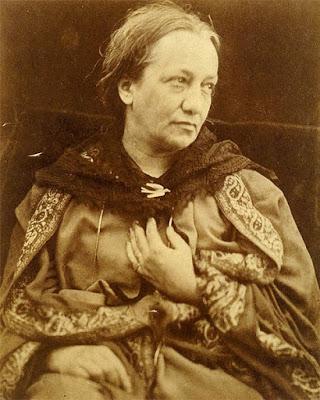
Julia Margaret Cameron (1873) Henry Herschel Hay Cameron
If you spend time looking at the work of Julia Margaret Cameron what will strike you first and foremost is her intense concentration on faces. Like Dante Gabriel Rossetti in the 1860s, primarily Julia's photographs focus on the interest and differences of expressions, beauty and the sweep of hair, often seemingly without much attention paid to costume and jewellery, but that is part of the genius of her work. We are drawn to her subject and it is only with a second look that we begin to notice the ornamentation and therein it is possible to find fascinating reuse and meaning in the details. As in her portrait above, the use of pattern, particularly paisley, and the sharpness of silver jewelry displays an awareness of what works within her medium and what adds to the power of her art.
Daughters of Jerusalem (1865)
Starting with what might be the most repeated of Julia's motifs, the dark shawl with paisley border, it seems to signify stoic courage. In Daughters of Jerusalem, it swathes the head of the central figure as they look down on a baby (in an expanded version). The paisley border provides a strong horizontal line in the center of the composition as the rest of the drapery flows in vertical lines, and also adds pattern to the plain clothes. Something about the thread used on the shawl shows brightly in the photographs, making it absolutely unmistakable, probably why Julia used it again and again.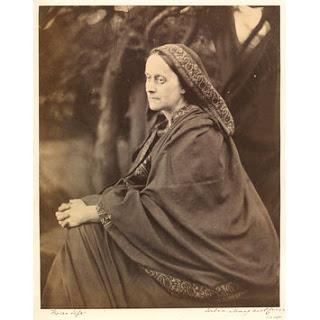
Lady Elcho as a Cumaean Sibyl (1865)
Again, the dark drapery on the classical figure is alleviated by the bright border that frames the face and draws attention to the curve of her arm. In what is a typical move, the shawl that draped Lady Elcho (mother of a member of The Souls), an aristocrat at the height of cultural society, also draped Julia's maid, Mary Hillier in a few of her photographs.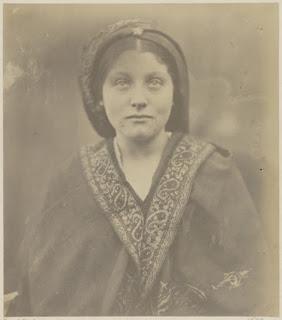
Hope (1864)

Kept in the Heart (1864)
An interesting point about Julia's use of ornamentation is that it is a social leveller; what a lady might wear on one day, the maid will wear the next. When you are in front of the lens, in the photographer's eyes all are equal.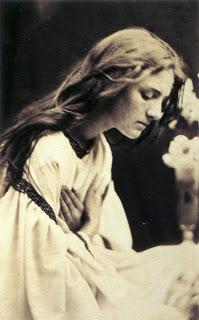
After the Manner of Perugino (1865-66)
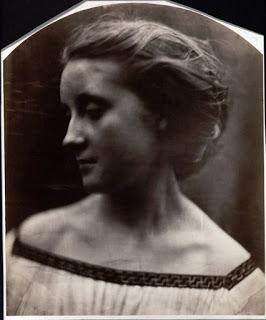
Untitled (1867)
Another common garment in the photographs is the white dress with dark edging. In the pictures above, the dress appears the same, just styled differently, the celtic/classical edge pattern cutting across the rich folds of white and providing a break between white fabric and white skin.
Zuleika (1871)
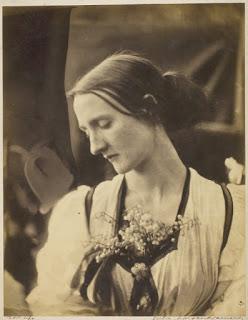
Mary Fisher (1866-67)
The black at the neck, shoulders, waist, arm bands and on edges all provides visual interest and contrast to a simple garment. By exploiting the interplay of white and black in her medium, Julia provides strong lines against delicate beauty and almost frames her subject within the frame of the image. Often the vertical lines, as in Mary Fisher above, lead the eye away before returning you to the focus, her face. They are pathways around the piece.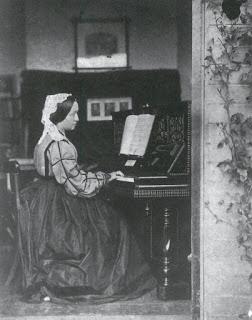
Julia Margaret Cameron at her piano (1863) Oscar Rejlander
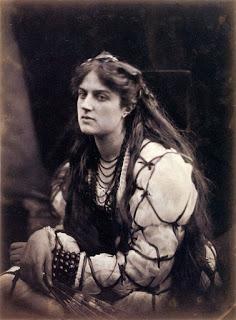
Hypatia (1868)
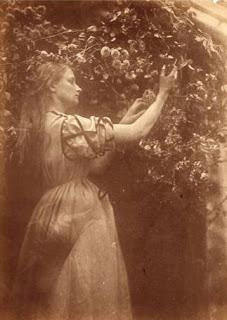
Maud or The Gardener's Daughter (1867-74)
Julia imposed her own sense of style on her photographs, and it is possible to find instances of her wearing a motif of her art in portraits, as seen with the paisley shawl, but also the unusual criss-cross sleeves which crop up in a number of her works. In the image of her at her piano, Julia's full sleeve is gathered and controlled by the frame of ribbon, a style repeated most notably in Hypatia where it is just possible to see that the entire dress is criss-crossed, and in Maud, where the sleeve is shortened. The dress or at least the sleeves occur repeatedly in pictures such as Gareth and Lynette and Yes or No. In most of these photographs, the sleeve is prominent, towards the viewer for display, luxuriously decorative.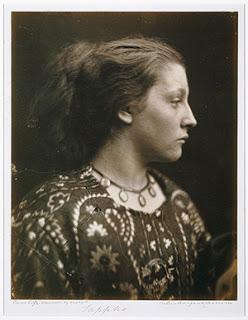
Sappho (1865)
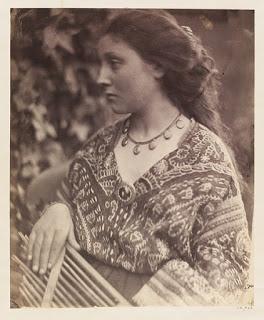
Sappho (1865)
In the boldest patterned dresses, rich with detail, Julia pictured her maid as the poet Sappho. The second dress caught my eye especially as it occurs again in a portrait photograph of Lady Richie...
Lady Richie and her Nieces (1868-72)
The square neckline has been folded to a point for Sappho, but the unmistakable curved lines following the bodice seams mean that this can only be the same dress worn by a maid pretending to be a classical poetess and Lady Richie, daughter of the novelist Thackeray. To drape maid and lady in the same shawl is one thing, but to put them in the same dress is a step further in muse equality.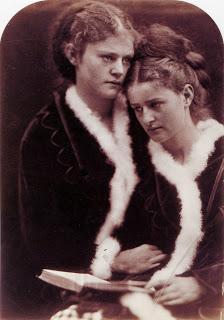
The Sisters (The Peacock Sisters) (1873)
Some fabrics take on a special quality in photographs. The fur trim in The Sisters and the related image The Angel of the House appears fluffy and glowing against the dark, possibly velvet robes. The use of pitch black, or at least dark enough shades that appear black in the photographs, is more unusual in her feminine works, but when used it brings out details such as the faces and hands, appearing pale against the darkness and more than ever draws your eye to the faces of the women and their expressions.It would not be possible to end the first part of this double post without mention Julia's gentlemen models and sitters. For the most part, the men appear in dignified portraits, dressed soberly in their own clothes to emphasis their faces and heads, such as this well known example...

Charles Darwin (1868-69)
...or swathed either in dark robes or a cloak, often with an attribute, hinting at their artistic, romantic nature...
Alfred Lord Tennyson, with book (1865)
Quite a number of her male sitters were from the literary world, as you would expect, so the large, floppy beret reoccurs, again adding to the artistic effect.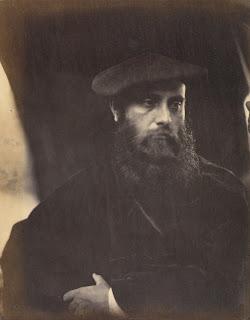
William Michael Rossetti (1865)
Her husband, Charles Hay Cameron, provided Julia with a male model for works such as Vivien and Merlin and King Lear and His Daughters, his wonderful beard and hair glowing, freshly washed, against his dark robes.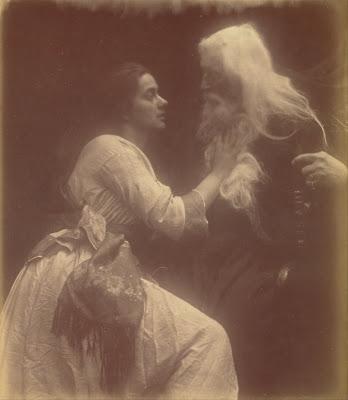
Vivien and Merlin (1874)
There is a strength of passion behind Julia's images of her husband which belay normal conventions of gravitas for a man of his age. There is almost fetishistic treatment of his hair, most apparent in this image, with Agnes Mangles (brilliant name) entangling her fingers in the snowy mass. It makes a refreshing and appropriate change to see a man of his age being treated as a sex object and interestingly you can see similarities in her treatment of Henry Taylor.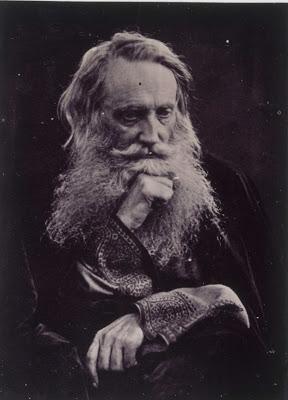
Henry Taylor (1865)
In a paisley edged robe, Henry Taylor was called upon to act as King David, as well as Prospero and Friar Laurence, with the beautiful young maids bowing before him. The attraction of Taylor as a model to Julia can be discerned in the way she portrays him, his hair providing a counterpoint to the formality of the dark robes. The hair in both men's case becomes a texture, a fabric which adds to the overall effect and meaning.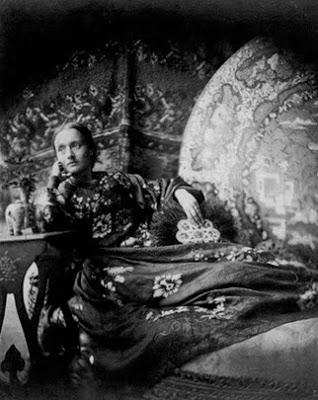
Annie Chinery Cameron (1873-78)
The use of fabric in Julia Margaret Cameron's works is both subtle and impactful. Whilst her obvious emphasis lies in the beautiful faces of her sitters, the interplay of fabric and pattern frames and highlights, acting as an indicator of wealth, luxury and exoticism. The paisley pattern may reference back to Julia's colonial heritage, but on the whole, as in the above image of Annie, her daughter in law, the use of Eastern motif is a shorthand for decorative beauty. In the work of Julia Margaret Cameron, the beauty of her subject was presented like a gift in the finest wrapping.In my second post, we'll take a closer look at the jewelry that held the magnificent costumes together...

